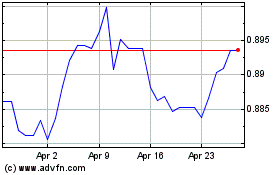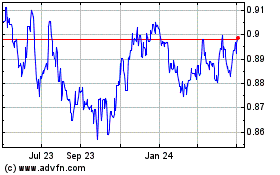UK Inflation Accelerates Unexpectedly In July
August 18 2020 - 11:17PM
RTTF2
UK consumer price inflation rose unexpectedly to a four-month
high in July on higher clothing and petrol prices, data from the
Office for National Statistics showed Wednesday.
Consumer price inflation rose to 1 percent in July, while the
rate was forecast to remain unchanged at 0.6 percent. This was the
highest rate since March.
Clothing, rising prices at the petrol pump, and furniture and
household goods made large upward contributions to inflation, while
falling food prices partially offset the annual increase.
At the August rate-setting meeting, the Bank of England had
forecast inflation to turn briefly negative in the near term,
falling to -0.3 percent in August driven by VAT cut and 'Eat Out to
Help Out' scheme.
According to BoE, inflation will fall further below the 2
percent target and average around 0.25 percent in the latter part
of the year, largely reflecting the direct and indirect effects of
Covid-19.
"The combination of VAT changes and the 'Eat Out to Help Out'
scheme mean we're set for a big downward move in August, while the
rise in unemployment means domestically-generated inflation is set
to remain muted," James Smith, an ING economist said.
On a monthly basis, consumer prices gained unexpectedly by 0.4
percent, faster than the 0.1 percent rise in June, data showed.
Prices were forecast to drop 0.1 percent.
Core inflation that excludes costs of energy, food, alcoholic
beverages and tobacco, accelerated to 1.8 percent from 1.4 percent
in June.
Another report from ONS showed that output prices declined for
the fourth straight month in July. Output prices fell 0.9 percent
annually, the same rate of decline as seen in June and in line with
economists' expectations.
Month-on-month, output prices gained again by 0.3 percent, as
expected, in July.
At the same time, the annual fall in input prices slowed to 5.7
percent in July from 6.7 percent in June.
Prices were expected to drop 6.1 percent. This was the sixth
consecutive month that the rate has been negative but the third
consecutive month that it has picked up.
On a monthly basis, input prices advanced 1.8 percent, slower
than the 3 percent rise in June but faster than economists'
forecast of 1.1 percent.
AUD vs CAD (FX:AUDCAD)
Forex Chart
From Mar 2024 to Apr 2024

AUD vs CAD (FX:AUDCAD)
Forex Chart
From Apr 2023 to Apr 2024
